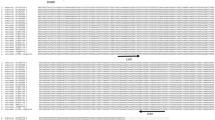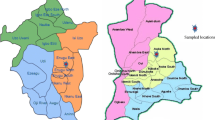Abstract
DNA-based identification of species for phylogenetic analysis as well as forensic identification is widely being carried out with the help of polymerase chain reaction (PCR). In this study, a successful effort has been made to identify 5 species of Indian freshwater turtles, including 3 hard-shell turtles (Geoemydidae), i.e.Kachuga dhongoka, K. kachuga andGeoclemys hamiltoni, and 2 species of soft-shell turtles (Trionychidae), i.e.Aspideretes gangeticus andLissemys punctata punctata, by using a well-optimized PCR-RFLP method. The analysis of nucleotide sequence variations in the PCR-amplified mitochondrialcyt-b genes (encoding cytochromeb) from the 5 species revealed its usefulness in the taxonomic differentiation of these species. On the basis ofcyt-b sequence data and the PCR-RFLP pattern, a phylogeny was developed to resolve the genetic relationships between these species, living in the same habitat type. In comparison, the PCR-RFLP of mitochondrial 16S rDNA genes appeared less decisive in analysing phylogenetic relationships or even in species differentiation. Further, the molecular method (PCR-RFLP) developed here is simple, rapid, reliable and reproducible; hence it can be routinely applied for species identification, essential for conservation and management of endangered chelonian species.
Similar content being viewed by others
References
Aranishi F, Okimoto T, Izumi S, 2005. Identification of gadoid species (Pisces, Gadidae) by PCR-RFLP analysis. J Appl Genet 46: 69–73.
Austin JD, Lougheed SC, Tanner K, Chek AA, Bogart JP, Boag PT, 2002. A molecular perspective on the evolutionary affinities of an enigmatic Neotropical frog,Allophryne ruthveni. Zool J Lin Soc 134: 335–346.
Avise JC, Arnold J, Ball RM, Bermingham E, Lamb T, Neigel JE, et al. 1987. Intraspecific phylogeography: the mitochondrial DNA bridge between population genetics and systematics. Ann Rev Ecol Sys18: 489–522.
Bowen BW, Nelson WS, Avise JC, 1993. A molecular phylogeny for marine turtles: trait mapping, rate assessment, and conservation relevance. Proc Nat Acad Sci 90: 4–7.
Caccone A, Amato G, Gratry OC, Behler J, Powell JR, 1999. A molecular phylogeny of four endangered Madagascar tortoises based on MtDNA sequences. Mol Phy Evol 12: 1–9.
Choudhury BC, Bhupathy S, Hanfee F, 2000. Status information on the tortoises and freshwater turtles of India. Proceedings of a Workshop on Conservation and Trade of Freshwater Turtles and Tortoises in Asia. In: Van Dijk PP, Stuart BL, Rhodin AGJ, eds. Asian Turtle Trade Chel Res Mono: 86–94.
Clarke SC, Magnussen, JE, Abercrombie DL, Mcallister MK, Shivji MS, 2006. Identification of shark species composition and proportion in the Hong Kong shark fin market based on molecular genetics and trade records. Conservation Biology 20: 201–211.
Cordes JF, Armknecht SL, Starkey EA, Graves JH, 2001. Forensic identification of sixteen species of Chesapeake Bay sportfishes using mitochondrial Restriction Fragment Length Polymorphism (RFLP) analysis. Estuaries 24: 49–58.
Engstrom TN, Shaffer HB, McCord WP, 2004. Multiple data sets, high homoplasy, and the phylogeny of softshell turtles (Testudines: Trionychidae). Syst Biol 53: 693–710.
Esposti MD, De-Vries S, Crimi M, Ghelli A, Patarnello T, Meyer A, 1993. Mitochondrial cytochromeb: evolution and structure of the protein. Bichem Biophys Acta 1143: 243–271.
Farrell LE, Roman J, Sunquist ME, 2000. Dietary separation of sympatric carnivores identified by molecular analysis of scats. Mol Ecol 9: 1583–1590.
Gaur A, Reddy A, Annapoorni S, Satyarebala B, Shivaji S, 2006. The origin of Indian Star tortoises (Geochelone elegans) based on nuclear and mitochondrial DNA analysis: A story of rescue and repatriation. Conservation Genetics 7: 231–240.
Griffiths LR, Bellis C, Ashton KJ, Freney L, Blair B, 2003. A molecular genetic approach for forensic animal species identification. Forensic Sci Int 134: 99–108.
Guha S, Kashyap VK, 2005. Development of novel heminested PCR assays based on mitochondrial 16s rRNA gene for identification of seven pecora species. BMC Genetics 6: 42.
Hall TA, 1999. BioEdit: a user-friendly biological sequence alignment editor and analysis program for Windows 95/98/NT. Nucleic Acids Symp Series 41: 95–98.
Hirayama R, 1984. Cladistic analysis of batagurine turtles (Batagurinae: Emydidae: Testudinoidea): a preliminary result. Stud Geol Salma 1: 141–157.
Hsieh HM, Huang LH, Tsai LC, Liu CL, Kuo YC, Hsiao CT, et al. 2006. Species identification ofKachuga tecta using the cytochromeb gene. J Foren Sci 51: 52–54.
IUCN, 2006. Summary statistics for globally threatened species. IUCN Species Survival Commission, Gland, Switzerland.
Jaccard P, 1908Nouvelles recherches sur la distribution florale. Bull Soc Vaudoise Sci Nat 44: 223–270.
Jerome M, Lemaire C, Bautista JM, Fleurence J, Ftienne M, 2003. Molecular phylogeny and species identification of sardines. J Agric Food Chem 51: 43–50.
Kim EJ, Young JJ, Kang SJ, Chang SY, Huh K, Nam DH, 2001. Molecular discrimination of Cervidae antlers and Rangifer antlers. J Biochem Mol Biol 34: 114–117.
Kocher TD, Thomas WK, Meyer A, Edwards SV, Paabo S, Villablanca FX, Wilson AC, 1989. Dynamics of mitochondrial DNA evolution in animals: Amplification and sequencing with conserved primers. Proc Nat Acad Sci 86: 196–200.
Kumar S, Tamura K, Nei M, 2004. MEGA3: Integrated software for molecular evolutionary genetics analysis and sequence alignment. Briefings in Bioinformatics 5: 150–163.
Lindstrom DP, 1999. Molecular species identification of newly hatched Hawaiian amphidromous gadoid larvae. Mar Biotech 1: 167–174.
Mattoccia M, Romano A, Sbordoni V, 2005. Mitochondrial DNA sequence analysis of the spectacled salamander,Salamandrina terdigitata (Urodela: Salamandridae), supports the existence of two distinct species. Zootaxa 995: 1–19.
McDowell JR, Graves JE, 2002. Nuclear and mitochondrial DNA markers for specific identification of istiophorid and xiphiid billfishes. Fish Bull 100: 537–544.
McDowell SB, 1964. Partition of the genusClemmys and related problems in the taxonomy of aquatic Testudinidae. Proc Zool Soc London 143: 239–279.
Meylan PA, 1987. The phylogenetic relationships of soft-shell turtles (family Trionychidae). Bulletin of American Museum of Natural History 186: 1–101.
Miyaki CY, Pereira SL, Biasia I, Wajntal A, 1997. DNA fingerprinting applied to captive breeding programs of parrots. Ararajuba, Brazilian J Ornithol 5: 127–133.
Mitchell SE, Cockburn AF, Seawright JA, 1993. The mitochondrial genome ofAnopheles quadrimaculatus species A: complete nucleotide sequence and organization. Genome. 36: 1058–1073.
Moore MK, Bemiss JA, Rice SM, Quattro JM, Woodley CM, 2003. Use of restriction fragment length polymorphisms to identify sea turtle eggs and cooked meats to species. Conservation Genetics 4: 95–103.
Nei M, 1987. Molecular evolutionary genetics. Columbia University Press, New York.
Palo JU, Merila J, 2003. A simple RFLP method for identification of two ranid frogs. Conservation Genetics 4: 801–803.
Palumbi S, Martin A, Romano S, McMillan WO, Stice L, Grabowski G, 1991. A simple fool’s guide to PCR. Department of Zoology and Kewalo Marine Laboratory, University of Hawaii, Honolulu, HI.
Parson W, Pegoraro K, Niederstätter H, Föger M, Steinlechner M, 2000 Species identification by means of the cytochromeb gene. Int J Leg Med 114 23–28.
Pfeiffer I, Burger J, Brenig B, 2004. Diagnostic polymorphism in mitochondrial cytochromeb gene allow discrimination between cattle, sheep, goat, roe buck and deer by PCR-RFLP. BMC Genetics 5: 30.
Praschag P, Hundsdörfer AK, Reza AHMA, Fritz U, 2007a. Genetic evidence for wild-livingAspideretes nigricans and a molecular phylogeny of South Asian softshell turtles (Reptilia: Trionychidae:Aspideretes, Nilssonia) Zool Scr 36: 301–310.
Praschag P, Hundsdörfer AK, Fritz U, 2007b. Phylogeny and taxonomy of endangered South and South-East Asian freshwater turtles elucidated by mtDNA sequence variation (Testudines: Geoemydidae:Batagur, Callagur, Hardella, Kachuga, Pangshura). Zool Scr 36: 429–442.
Purcell M, Mackey G, LaHood E, 2004. Molecular methods for the genetic identification of salmonid prey from Pacific harbor seal (Phoca vitulina richardsi) scat. Fish Bull 102: 213–220.
Rao RJ, 2006. Species diversity, habitat features and conservation of freshwater turtles in the Chambal river, Madhya Pradesh, India. Chelonii 4: 23–27.
Rhodin AGJ, 2002. Conservation and trade of freshwater turtles and tortoises in Asia: review of status and threats using IUCN Red List and CITES criteria. CITES Technical Workshop on Trade in Freshwater Turtles and Tortoises in Asia. Kunming, China: 32–45.
Rohilla MS, Rao RJ, Tiwari PK, 2006. Use of peripheral blood lymphocyte culture in the karyological analysis of Indian freshwater turtles,Lissemys punctata andGeoclemys hamiltoni. Curr Sci 90: 1130–1134.
Rozas J, Sanchez-DelBarrio JC, Messeguer X, Rozas R, 2003. DnaSP, DNA polymorphism analyses by the coalescent and other methods. Bioinformatics 19: 2496–2497.
Russell VJ, Hold GL, Pryde SE, Rehbein H, Quinteiro J, Rey-Mendez M, et al. 2000. Use of restriction fragment length polymorphism to distinguish between salmon species. J Agric Food Chem 48: 2184–2188.
Sambrook J, Russell DW, 2001Molecular cloning: a laboratory manual, 3rd ed. New York: Cold Spring Harbor Laboratory Press.
Schneider TD, Stephens RM, 1990 Sequence Logos: a new way to display consensus sequences. Nucleic Acids Res 18: 6097–6100.
Spinks PQ, Shaffer HB, Iverson JB, McCord WP, 2004 Phylogenetic hypotheses for the turtle family Geoemydidae. Mol Phy Evol 32: 164–182.
Tajima F, 1989. Statistical method for testing the neutral mutation hypothesis by DNA polymorphism. Genetics. 123: 585–595.
Thompson JD, Higgins DG, Gibson TJ, 1994. CLUSTAL W: improving the sensitivity of progressive multiple sequence alignment through sequence weighting, position-specific gap penalties and weight matrix choice. Nucleic Acids Res 22: 4673–4680.
Vences M, Thomas M, Meijden AVD, Chiari Y, Vieites DR, 2005. Comparative performance of the 16S rRNA gene in DNA barcoding of amphibians. Fron Zool 2: 5.
Whitfield JB, Cameron AS, 1998. Hierarchical analysis of variation in the mitochondrial 16S rRNA gene among Hymenoptera. Mol Bio Evol 15: 1728–1743.
Zehner R, Zimmermann S, Mebs D, 1998. RFLP and sequence analysis of the cytochromeb gene of selected animals and man: methodology and forensic application. Int J Leg Med 111: 323–327.
Author information
Authors and Affiliations
Corresponding author
Rights and permissions
About this article
Cite this article
Rohilla, M.S., Tiwari, P.K. Restriction fragment length polymorphism of mitochondrial DNA and phylogenetic relationships among five species of Indian freshwater turtles. J Appl Genet 49, 167–182 (2008). https://doi.org/10.1007/BF03195610
Received:
Revised:
Accepted:
Issue Date:
DOI: https://doi.org/10.1007/BF03195610




